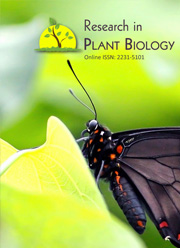In vitro propagation of a rare succulent medicinal plant Caralluma diffusa (Wight) N.E.Br
Keywords:
Caralluma diffusa, indirect organogenesis, endemic, nodal explantAbstract
Caralluma diffusa (Wight) N.E.Br is rare and an endemic medicinally important plantbelonging to the family Asclepiadaceae. A cost effective and efficient protocol has beendescribed in the present work for large scale and rapid propagation through in vitro organogenesis using nodal explants cultured on Murashige and Skoog’s (MS) media fortifiedwith BAP, 2,4-D, NAA and Kn. The highest frequency ( 83.3%) of callus was observed in MSmedium containing NAA (2mg/L) in combination with BAP (0.5mg/L) + Kn (0.25mg/L).Development of highest percentage of shoot organogenesis (82.4%) occurred when the calliwere sub cultured in MS medium supplemented with combination of BAP + NAA + Kn (2.0+ 0.5 + 0.25mg/L). Multiple shoots were induced from the nodal segments cultured onmedium containing BAP or Kn alone or in combination. Highest number of shoots(6.40±0.34) and maximum length of shoots (6.61±1.01cm) were obtained on MS mediumcontaining BAP (2.5mg/L). These shoots were then cultured on half strength MS mediumsupplemented with various concentrations of IBA and NAA. Highest percentage of rooting(78.4%) and mean length of rootlets was observed on IBA (0.5mg/L) in combination withNAA (0.5mg/L). In vitro derived plantlets were hardened and acclimatized. About 98% ofplantlets survived in field condition. The method described here can be successfully employed for large scale multiplication, long term in vitro conservation. This is the firstreport on indirect organogenesis of universally threatened cacti C. diffusa.Downloads
Download data is not yet available.
Published
08-02-2013
How to Cite
Prabu M, K., P, S., B, S., V, T., & T, B. (2013). In vitro propagation of a rare succulent medicinal plant Caralluma diffusa (Wight) N.E.Br. Research in Plant Biology, 3(1). Retrieved from https://updatepublishing.com/journal/index.php/ripb/article/view/2524
Issue
Section
Articles



 .
. 